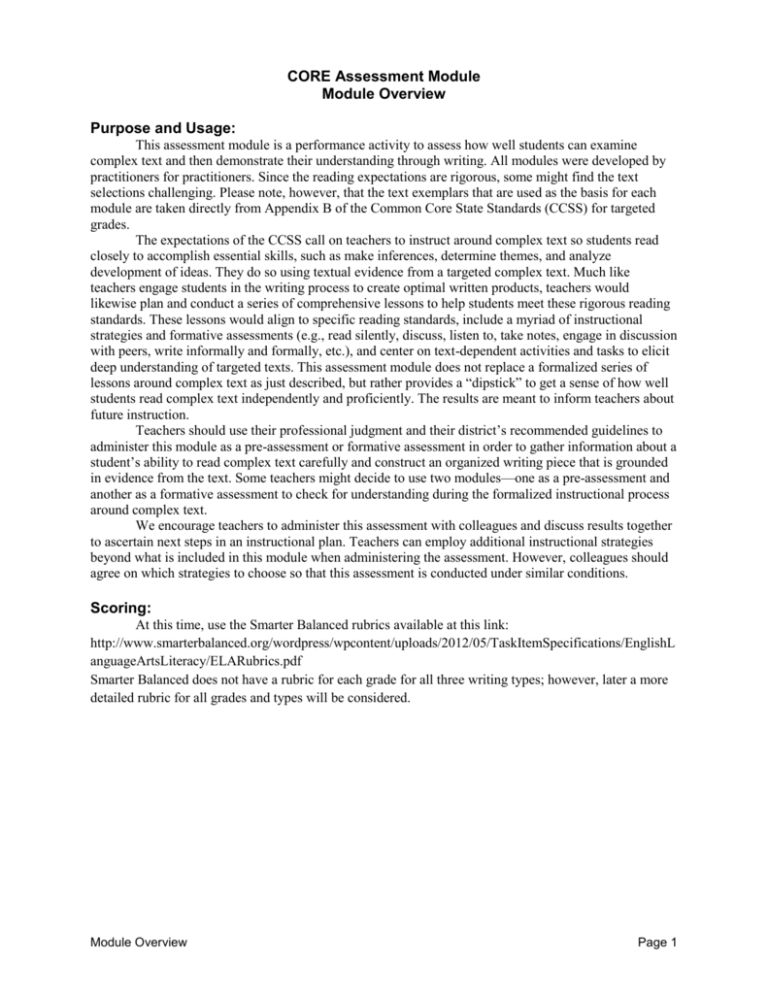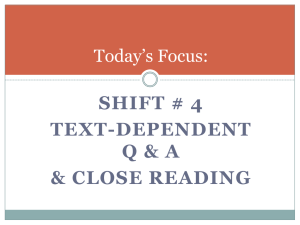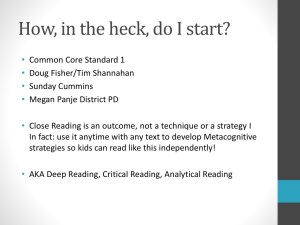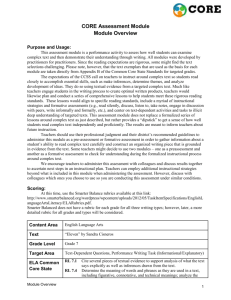Words We Live By
advertisement

CORE Assessment Module Module Overview Purpose and Usage: This assessment module is a performance activity to assess how well students can examine complex text and then demonstrate their understanding through writing. All modules were developed by practitioners for practitioners. Since the reading expectations are rigorous, some might find the text selections challenging. Please note, however, that the text exemplars that are used as the basis for each module are taken directly from Appendix B of the Common Core State Standards (CCSS) for targeted grades. The expectations of the CCSS call on teachers to instruct around complex text so students read closely to accomplish essential skills, such as make inferences, determine themes, and analyze development of ideas. They do so using textual evidence from a targeted complex text. Much like teachers engage students in the writing process to create optimal written products, teachers would likewise plan and conduct a series of comprehensive lessons to help students meet these rigorous reading standards. These lessons would align to specific reading standards, include a myriad of instructional strategies and formative assessments (e.g., read silently, discuss, listen to, take notes, engage in discussion with peers, write informally and formally, etc.), and center on text-dependent activities and tasks to elicit deep understanding of targeted texts. This assessment module does not replace a formalized series of lessons around complex text as just described, but rather provides a “dipstick” to get a sense of how well students read complex text independently and proficiently. The results are meant to inform teachers about future instruction. Teachers should use their professional judgment and their district’s recommended guidelines to administer this module as a pre-assessment or formative assessment in order to gather information about a student’s ability to read complex text carefully and construct an organized writing piece that is grounded in evidence from the text. Some teachers might decide to use two modules—one as a pre-assessment and another as a formative assessment to check for understanding during the formalized instructional process around complex text. We encourage teachers to administer this assessment with colleagues and discuss results together to ascertain next steps in an instructional plan. Teachers can employ additional instructional strategies beyond what is included in this module when administering the assessment. However, colleagues should agree on which strategies to choose so that this assessment is conducted under similar conditions. Scoring: At this time, use the Smarter Balanced rubrics available at this link: http://www.smarterbalanced.org/wordpress/wpcontent/uploads/2012/05/TaskItemSpecifications/EnglishL anguageArtsLiteracy/ELARubrics.pdf Smarter Balanced does not have a rubric for each grade for all three writing types; however, later a more detailed rubric for all grades and types will be considered. Module Overview Page 1 Content Area Text Grade Level Target Area Common Core State Standards SBAC Assessment Claims Task Overview Module Components English Language Arts The Words We Live By, by Linda R. Monk (excerpt) Grade 7 Text-Dependent Questions, Performance Writing Task (Argument) RI 7.1 Cite several pieces of textual evidence to support analysis of what the text says explicitly as well as inferences drawn from the text. RI 7.2 Determine two or more central ideas in a text and analyze their development over the course of the text; provide an objective summary of the text. RI 7.3 Analyze the interactions between individuals, events, and ideas in a text (e.g., how ideas influence individuals or events, or how individuals influence ideas or events). RI 7.4 Determine the meaning of words and phrases as they are used in a text, including figurative, connotative, and technical meanings; analyze the impact of a specific word choice on meaning and tone. RI 7.5 Analyze the structure an author uses to organize a text, including how the major sections contribute to the whole and to the development of the ideas. W 7.1 Write arguments to support claims with clear reasons and relevant evidence. W 7.4. Produce clear and coherent writing in which the development, organization, and style are appropriate to task, purpose, and audience. W 7.9 Draw evidence from literary or informational texts to support analysis, reflection, and research. *SL 7.1 Engage effectively in a range of collaborative discussions (one-on-one, in groups, and teacher-led) with diverse partners on grade 7 topics, texts, and issues, building on others’ ideas and expressing their own clearly. *SL 7.4 Present claims and findings, emphasizing salient points in a focused, coherent manner with pertinent descriptions, facts, details, and examples; use appropriate eye contact, adequate volume, and clear pronunciation. Claim 1: Students can read closely and analytically to comprehend a range of increasingly complex literary and informational texts. Claim 2: Students can produce effective and well-grounded writing for a range of purposes and audiences. This assessment task will be completed in two parts. The prewriting/planning in part one will involve reading, speaking and listening, and note-taking around text-dependent questions. In part two, students will be asked to draft an argument. 1) Directions to Teacher 2) Text Passage 3) Text-Dependent Questions Graphic Organizer 4) Writing Task *Standard addressed but not explicitly assessed. Module Overview ELA Grade 7: Words We Live By Page 2 The Words We Live By Directions to Teacher This Common Core-aligned ELA Performance Task can be given over two to three days depending on class schedules. The directions below outline the steps to follow for a two-day administration. Text: Monk, Linda R. The Words We Live By: Your Annotated Guide to the Constitution. New York: Hyperion, 2003. (2003) From the Introduction: “The Preamble: We the People.” Materials: The Words We Live By Text Passage Text-Dependent Questions and Peer Discussion Graphic Organizer Independent Writing Task Lined paper for writing Day 1 1. Reading: (Approximately 10 minutes) Distribute the Text Passage The Words We Live By and instruct students to read it silently, noting the terms defined in the margins. 2. Note-Taking Around Text-Dependent Questions: (Approximately 20 minutes) Distribute the Text-Dependent Questions Graphic Organizer. Ask students to reread the passage and complete “My Response” and “Evidence From the Text.” Encourage students to think deeply and respond thoughtfully to each question. a. Word Meaning – The Constitution establishes the principle of popular sovereignty. Based on the excerpt, what is the definition of “popular sovereignty”? Why is the phrase “We the People” important to understanding this principle? b. Reasoning/Evaluation – Why does the author include the quotation from Thurgood Marshall? What is Marshall’s point, and what perspective does he bring to the author’s argument? c. Key Details – When the Constitution was first written, to whom did “We the People” refer? What can you infer about the beliefs of the founders who wrote or supported the document? d. Central Ideas – Why did the author most likely choose the title The Words We Live By? How does the title connect to the evolving definition of “We the People”? ELA Grade 7: Words We Live By Page 3 3. Speaking/Listening Questions: (Approximately 15 minutes) In pairs or groups of three, give students time to discuss their responses to the text-dependent questions. Remind and encourage them to include textual evidence during their discussions. After a designated period of time, instruct students to independently complete the “My Thoughts Now” section of the Text-Dependent Questions Graphic Organizer based on their peer conversations. Tell them they will respond to a writing prompt and can use the graphic organizer while writing. Day 2 4. Performance Task (Writing Prompt) (Approximately 50 minutes) Distribute the writing prompt, and let students know the amount of time they have to respond to it. Encourage students to use their graphic organizers to inform their writing. ELA Grade 7: Words We Live By Page 4 The Words We Live By Text Passage legislature: elected body that creates laws advocate: one who argues for a cause The first three words of the Constitution are the most important. They clearly state that the people—not the king, not the legislature, not the courts—are the true rulers in American government. This principle is known as popular sovereignty. But who are “We the People”? This question troubled the nation for centuries. As Lucy Stone, one of America’s first advocates for women’s rights, asked in 1853, “ ‘We the People’? Which ‘We the People’? The women were not included.” Neither were white males who did not own property, American Indians, or African Americans—slave or free. Justice Thurgood Marshall, the first African American on the Supreme Court, described the limitation: for a sense of the evolving nature of the constitution, we need look no further than the first three words of the document’s preamble: ‘we the people.’ when the founding fathers used this phrase in 1787, they did not have in mind the majority of America’s citizens . . . the men who gathered in Philadelphia in 1787 could not . . . have imagined, nor would they have accepted, that the document they were drafting would one day be construed by a Supreme Court to which had been appointed a woman and the descendant of an African slave. amendment: formal change sovereignty: the ultimate supreme power construed: interpreted Through the Amendment process, more and more Americans were eventually included in the Constitution’s definition of “We the People.” After the Civil War, the Thirteenth Amendment ended slavery, the Fourteenth Amendment gave African Americans citizenship, and the Fifteenth Amendment gave black men the vote. In 1920, the Nineteenth Amendment gave women the right to vote nationwide, and in 1971, the Twenty-sixth Amendment extended suffrage to eighteen-year-olds. Monk, Linda R. The Words We Live By: Your Annotated Guide to the Constitution. New York: Hyperion, 2003. (2003) From “The Preamble: We the People.” ELA Grade 7: The Words We Live By Page 5 suffrage: the right to vote Student Name ______________________ Text-Dependent Questions Graphic Organizer Directions: After rereading the text, write answers to each question below in the “My Response” section. Support each response by recording textual evidence in the “Evidence From the Text” section. After you are given time to talk to a classmate and share ideas, complete the “My Thoughts Now” section based on your conversation. 1. The Constitution establishes the principle of popular sovereignty. Based on the excerpt, what is the definition of “popular sovereignty”? Why is the phrase “We the People” important to understanding this principle? My Response Evidence From the Text My Thoughts Now 2. Why does the author include the quotation from Thurgood Marshall? What is Marshall’s point, and what perspective does he bring to the author’s argument? My Response Evidence From the Text My Thoughts Now ELA Grade 7: The Words We Live By Page 6 Student Name ______________________ 3. When the Constitution was first written, to whom did “We the People” refer? What can you infer about the beliefs of the founders who wrote or supported the document? My Response Evidence From the Text My Thoughts Now 4. Why did the author most likely choose the title The Words We Live By? How does the title connect to the evolving definition of “We the People”? My Response Evidence From the Text My Thoughts Now ELA Grade 7: The Words We Live By Page 7 Student Name ______________________ The Words We Live By Writing Task Directions: Please respond to the prompt below in writing. You may use your graphic organizer to inform your writing. Writing Prompt After reading the excerpt from Linda R. Monks’s The Words We Live By, describe how the title of the book reflects the ideas that the author presents in the excerpt. Be Sure To: Provide a clear introduction. Support your points with evidence from the text, such as relevant facts, definitions, concrete details, and quotations. Use appropriate transitions. Use precise language and vocabulary. Establish and maintain a formal style. Provide a conclusion that supports your analysis. ELA Grade 7: The Words We Live By Page 8





